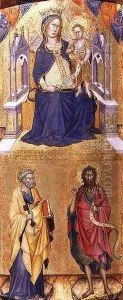Francesco di Vannuccio Paintings
Francesco di Vannuccio was an Italian painter of the Sienese School during the Gothic period, active mainly in the latter half of the 14th century. While there is scant information on the early life of Francesco di Vannuccio, it is believed that he was born around 1330, based on stylistic analyses of his works and the historical context of his active years. His contributions to art are primarily known through religious panel paintings and illuminated manuscripts, which reflect the detailed, devout, and elegant characteristics of the Sienese School of the time.
Francesco di Vannuccio's work is distinguished by its refined use of color, intricate ornamentation, and the delicate portrayal of figures, typical of the Sienese tradition, which was deeply influenced by Byzantine art. Unlike the more dramatic and emotional style of the Florentine painters of his era, di Vannuccio's art is noted for its serenity, grace, and a focus on spiritual beauty. His paintings often featured religious themes, with a particular emphasis on the Madonna and Child, a popular subject among Sienese painters, reflecting the city's deep Marian devotion.
One of di Vannuccio's most recognized works is the 'Madonna and Child with Saints,' a testament to his ability to create compositions that are both richly decorative and imbued with a sense of devotional calm. His technique of using gold leaf in backgrounds, a hallmark of Gothic painting, added a divine luminosity to his figures, further emphasizing their spiritual significance.
Despite the limited number of surviving works confidently attributed to him, Francesco di Vannuccio's contribution to the Sienese School is significant. His art represents a bridge between the medieval sensibilities of the early 14th century and the emerging Renaissance attitudes that would come to dominate Italian art. He died around 1400, leaving behind a legacy that, while not as widely recognized as that of contemporaries like Simone Martini or Duccio di Buoninsegna, is nonetheless an important link in the evolution of Sienese painting.
